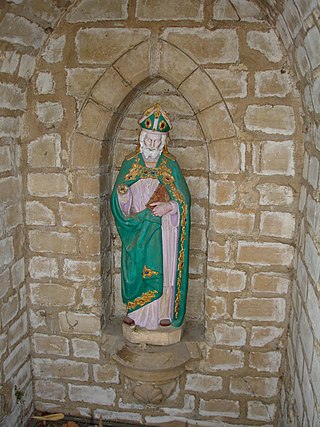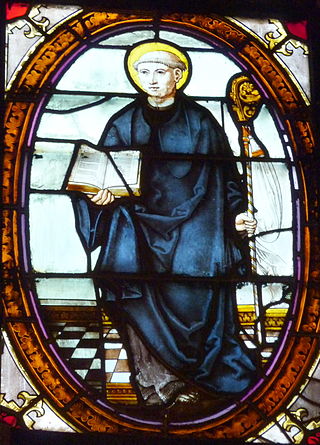
Abbot is an ecclesiastical title given to the male head of a monastery in various Western religious traditions, including Christianity. The office may also be given as an honorary title to a clergyman who is not the head of a monastery. The female equivalent is abbess.
Pope Stephen IX was the head of the Catholic Church and ruler of the Papal States from 3 August 1057 to his death in 29 March 1058. He was a member of the Ardenne-Verdun family, who ruled the Duchy of Lorraine, and started his ecclesiastical career as a canon in Liège. He was invited to Rome by Pope Leo IX, who made him chancellor in 1051 and one of three legates to Constantinople in 1054. The failure of their negotiations with Patriarch Michael I Cerularius of Constantinople and Archbishop Leo of Ohrid led to the permanent East-West Schism. He continued as chancellor to the next pope, Victor II, and was elected abbot of the Benedictine monastery of Montecassino.

Pope Victor III, was the head of the Catholic Church and ruler of the Papal States from 24 May 1086 to his death. He was the successor of Pope Gregory VII, yet his pontificate is far less notable than his time as Desiderius, the great abbot of Montecassino.

Amandus, commonly called Saint Amand, was a bishop of Tongeren-Maastricht and one of the great Christian missionaries of Flanders. He is venerated as a saint, particularly in France and Belgium.

Odo of Cluny was the second abbot of Cluny. He enacted various reforms in the Cluniac system of France and Italy. He is venerated as a saint by the Catholic and Eastern Orthodox Churches. His feast day is 18 November.

March 24 - Eastern Orthodox liturgical calendar - March 26
Jonas of Bobbio was a Columbanian monk and a major Latin monastic author of hagiography. His Life of Saint Columbanus is "one of the most influential works of early medieval hagiography."

Anglo-Saxon missionaries were instrumental in the spread of Christianity in the Frankish Empire during the 8th century, continuing the work of Hiberno-Scottish missionaries which had been spreading Celtic Christianity across the Frankish Empire as well as in Scotland and Anglo-Saxon England itself during the 6th century. Both Ecgberht of Ripon and Ecgbert of York were instrumental in the Anglo-Saxon mission. The first organized the early missionary efforts of Wihtberht, Willibrord, and others; while many of the later missioners made their early studies at York.
Saint Remaclus was a Benedictine missionary bishop.
There is archaeological evidence of insular monasticism as early as the mid 5th century, influenced by establishments in Gaul such as the monastery of Martin of Tours at Marmoutier, the abbey established by Honoratus at Lérins; and that of Germanus at Auxerre. Many Irish monks studied at Candida Casa near Whithorn in what is now Galloway in Scotland.

The Abbey of Saint-Germain d'Auxerre is a former Benedictine monastery in central France, dedicated to its founder Saint Germain of Auxerre, the bishop of Auxerre, who died in 448. It was founded on the site of an oratory built by Germanus in honor of Saint Maurice.

Martin Marty was a Swiss-born Benedictine missionary and bishop in the United States. His birth name was James Joseph Alois Marty.
Saint Romaric was a Frankish nobleman who lived in Austrasia from the late 6th century until the middle of the 7th century. He and Amatus of Grenoble founded Remiremont Abbey.

Saint Praejectus, Prejectus or Projectus (625–676) was a bishop of Clermont, who was killed together with the abbot Amarinus as a result of political struggles of the day.

The Abbey of Saint-Evroul or Saint-Evroul-sur-Ouche is a former Benedictine abbey in Normandy, located in the present commune of Saint-Evroult-Notre-Dame-du-Bois, Orne, Normandy. It has been classified as a historical monument since 1967. Its name refers to its founder, Ebrulf (Evroul), who founded a hermitage in the forest of Ouche around 560. The abbey was rebuilt around 1000.

Maroilles Abbey was a Benedictine monastery in Maroilles in the department of Nord, France. It was founded around 650 and suppressed in the French Revolution.
Bernard of Thiron, also known as Bernard of Ponthieu and Bernard of Abbeville, was the founder of the Tiron Abbey and the Tironensian Order.

Saint Mederic or Medericus, also known in French as Saint Merri or Médéric, was a monk and a hermit, who is considered patron saint of the right bank of the river Seine in central Paris.

Ignatius Conrad was a Benedictine monk, a Swiss missionary, and the first Abbot of Subiaco Abbey in Arkansas, which was named as an abbey in 1891. He served from 1892 to 1925. Fr Ignatius Conrad initially worked with the German Catholic communities in the south-western region of the United States.

Saint Geremarus was a Frankish monk and abbot. His feast day is 24 September.













